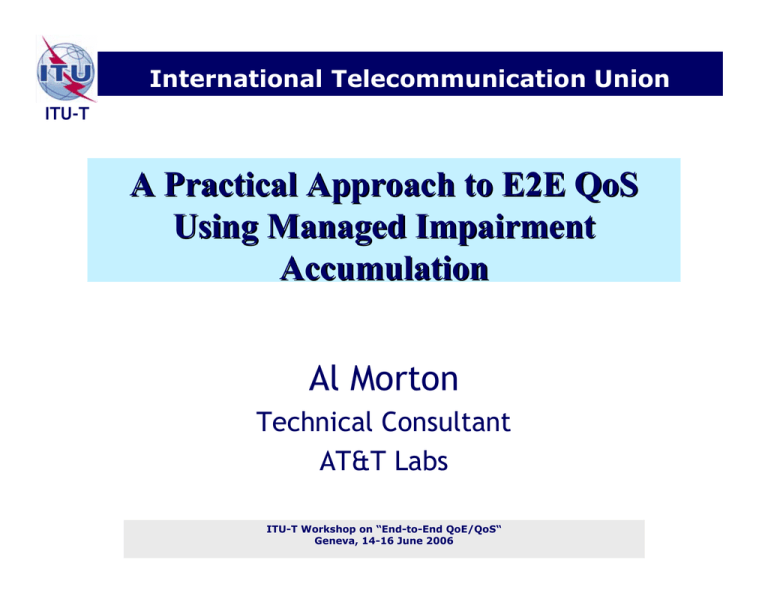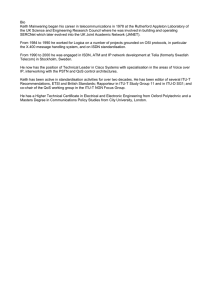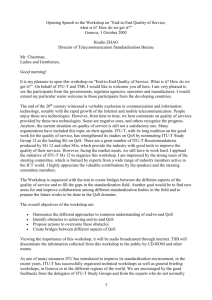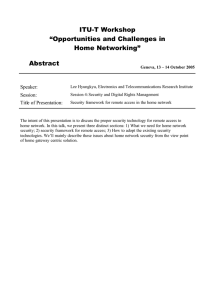A Practical Approach to E2E QoS Using Managed Impairment Accumulation
advertisement

International Telecommunication Union ITU-T A Practical Approach to E2E QoS Using Managed Impairment Accumulation Al Morton Technical Consultant AT&T Labs ITU-T Workshop on “End-to-End QoE/QoS“ Geneva, 14-16 June 2006 Outline ITU-T o Problem Statements • Users, Net Operators and Equip. Developers o Assumptions and Issues/Challenges o Current Assets brought to bear • Standardized Obj./Measurement/Estimation o Impairment Accumulation Process o Comparison of Alternative Approaches o Overlay on Standards Developments o Summary ITU-T Workshop on “End-to-End QoE/QoS“ Geneva, 14-16 June 2006 2 Viewpoints of QoS ITU-T I need the network to: + support my app, or + meet my app’s req. CUSTOMER I want my app. to work Customer’s QOS Requirements QOS Perceived By Customer From ITU-T G.1000 SERVICE PROVIDER QOS Offered By Provider How can I meet the reqs? work with other SPs ? QOS Achieved by Provider Here’s how we interpreted/ satisfied your request within the network ITU-T Workshop on “End-to-End QoE/QoS“ Geneva, 14-16 June 2006 3 QoS Agreements - Automated ITU-T User Term/Adapter Network(s) Translated Packet Trans Request Requirements (BW, Loss…) ACK/REJ/Mod Cnfg.Choices QoS Classes & Decisions Topo/Policy Design/Eng. Request QoS Requirements ACK/REJ/Mod Objectives Reality Provisioning QoS Mech. Feedback Perceived QoS Monitoring Application Performance Packet Performance ITU-T Workshop on “End-to-End QoE/QoS“ Geneva, 14-16 June 2006 Perf. Mgmt. Reports (SLAs) 4 Assumptions and Issues/Challenges ITU-T Decision: QoS or no QoS? If QoS requested, assume: o Managed Networks offering SLAs o National Constraints on some networks o Response Required Challenges: o Desire Perf. Estimate o Multi-Net Participation o Impair. Highly Variable o Distance may be unknown o Process Automation UNI UNI Network 1 Network 2 measurements …Network N N varies ITU-T Workshop on “End-to-End QoE/QoS“ Geneva, 14-16 June 2006 5 Standards Assets Brought to Bear ITU-T o Bandwidth/Traffic Descriptions – many • Need ability to over-book = “statistical reservation” o Network Performance Objectives – Y.1541 • Supports a wide range of user applications • Applications supported by Classes of Network QoS — Simplify requests and make them manageable • Includes functions to combine performance of multiple nets and estimate Edge-Edge Perf. — IETF IPPM examining more functions & limits o Agreements on How and What to Measure • TR- Performance Monitoring & Mgmt -> Y.PM/Y.PMM o Signaling – IETF NSIS QSPEC (meets most Sup 51 req) ITU-T Workshop on “End-to-End QoE/QoS“ Geneva, 14-16 June 2006 6 Impairment Accumulation Process ITU-T Determine Path UNI UNI Sub-path 2 Sub-path 1 Measurement Sets M1 Sub-path 3 M2 Composition Functions M3 (Y.1541, clause 8) Composed UNI-UNI Performance No + offer alt. Class, or + seek alternate path Composed Perf. Meets Objectives? ITU-T Workshop on “End-to-End QoE/QoS“ Geneva, 14-16 June 2006 Yes Inform Requestor (Done) 7 Comparison of Alternatives ITU-T Make Assumptions on Path (# Networks) Allocate Perf. to Nets according to Assumptions Measurements Verify Allocations (Negotiation) Compare Actual Path to Assumptions Make Measurements, Determine Path Combine Meas. using Composition Functions Determine Performance Remnants, if any Determine “Custom” Tolerance for each Net Impairment Accumulation Nets Managed to meet User needs, Compete Favorably, and/or Meet Regulations replace the steps above. Additional Steps for Ranged Allocation Approach ITU-T Workshop on “End-to-End QoE/QoS“ Geneva, 14-16 June 2006 Decision & Response Static/Other Allocation Approaches 8 Comparison of Alternatives (2) ITU-T UNI Sub-Path Performance 10-4 Loss 10 Loss 10 Loss Delay 22.4 ms Delay 10.6 ms Delay 34.4 ms Jitter 25 ms Jitter 2 ms Jitter 25 ms -4 -4 UNI Signaling Protocol Accumulated Performance Request: Y.1541 Class 0 Loss 10-4 Loss 2x10-4 Loss 3 x10-4 Delay 22.4 ms Delay 33 ms Delay 67.4 ms Jitter 25 ms Jitter 26 ms Jitter 47.5 ms Response: ACK Class 0 with this performance estimate Static Allocation (large enough for any network above) UNI UNI Delay 35ms Jitter 25ms Delay 35ms Jitter 25ms ITU-T Workshop on “End-to-End QoE/QoS“ Geneva, 14-16 June 2006 Delay 35ms Jitter 25ms Does not meet Class 0 9 Overlay on Stds Development ITU-T Offering Quantified Network Performance in response to Users Requests is Required for NGN, just as is done today with static agreements. So… o RACF must be ready to speak performance across Network Operator’s Boundaries • Collect necessary info and make Decisions to Support Offering Y.1541 Classes • Controlling Resources on the Basis of BW alone is not sufficient o Implications for Signaling Protocols, too ITU-T Workshop on “End-to-End QoE/QoS“ Geneva, 14-16 June 2006 10 Summary ITU-T o Users will Require Quantified Performance Commitments, as well as application assurance by category o Network Operators Need Additional Capabilities to meet User’s Needs in the Multi-operator environ. o Impairment Accumulation describes both a set of Techniques and a Process: • Composed Estimates may succeed where Alloc. fails • Process has the flexibility and simplicity for a wide range of circumstances • Benefits from Existing Emphasis on Managed Nets o Progress toward Assuring E2E QoS ITU-T Workshop on “End-to-End QoE/QoS“ Geneva, 14-16 June 2006 11


